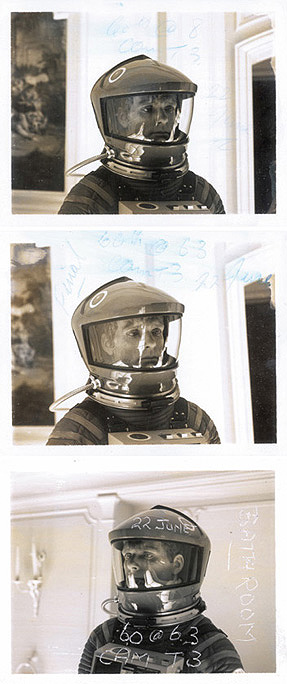Stanley Kubrick: I was born in New York. My father was a doctor. My parents had wanted me to be a doctor but I was such a misfit in high school that when I graduated I didn't have
the marks to get into college. So, like almost everything else good that's ever happened to
me, by the sheerest stroke of good luck, I had a very good friend on Look Magazine [...].
She asked me if I would like a job [...]. After about six months I was finally made a staff
photographer. My highest salary was $105 a week. But I travelled around the country and I
went to Europe. I learned a lot about people and things. And then, I made a documentary film
called DAY OF THE FIGHT about a boxer called Walter Cartier. It cost me around $3.900 and I
sold it to RKO for $4.000. So I thought there was a great future in making documentaries, but
I didn't make any money on any of the films I made. Then I made a feature FEAR AND DESIRE and
then KILLER'S KISS. That led to THE KILLING, and my association with the producer Jim Harris.
We did PATHS OF GLORY and LOLITA together."
Published in: The Guardian (London) 16.07.1999.
Father: Jacques L. Kubrick
Stanley Kubrick was the son of a doctor. His Jewish paternal grandparents stemmed from Austria and Romania.
| |
|
| |
|
| 1928 |
Stanley Kubrick is born on July 26, 1938 in The Bronx, New York |
| 1934 |
Birth of his sister Barbara Kubrick |
| 1938-1940 |
Attends public school P.S. 90, The Bronx, New York |
| 1941 |
At the age of 13 Stanley Kubrick receives a
Graflex-camera from his father. |
| 1941-1945 |
Attends the William Howard Taft High School, The Bronx, New York |
| 1945 |
On June 26 Look buys for $25 a photograph by Stanley Kubrick.
It shows a saddened newsventor on the day President Franklin D. Roosevelt died. |
| 1946 |
Kubrick becomes a staff photographer for Look (until 1951). |
| 1947 |
On August 15 Kubrick gains his pilot license. |
| 1948 |
Marriage to Toba Metz (subsequently divorced) |
| 1949 |
Moves to Greenwich Village, Manhattan |
| 1951 |
Kubrick’s first documentary DAY OF THE FIGHT about the boxer Walter
Cartier has its premiere in New York |
| 1951 |
Kubrick directs FLYING PADRE, a short film about a priest who ministers his parish in New Mexico by aeroplane. |
| 1953 |
Kubrick shoots his first colour film, THE SEAFARERS, a documentary on the Seafarers' International Union. |
| 1953 |
Kubrick produces and directs his first theatrical feature, FEAR AND DESIRE. |
| 1953 |
Katharina Christiane born to Christiane Susanne Harlan (Kubrick's future wife) and Werner Bruhns. |
| 1955 |
Marriage to dancer Ruth Sobotka (subsequently divorced) |
| 1955 |
KILLER'S KISS |
| 1956 |
Stanley Kubrick and James B. Harris found their own film production company
– Harris Kubrick Pictures (until 1963). |
| 1956 |
THE KILLING |
| 1957 |
During the shooting of PATHS OF GLORY in Munich Stanley Kubrick meets the actress
Susanne Christian, née Christiane Susanne Harlan. |
| 1957 |
Marriage to Susanne Christian |
| 1957 |
PATHS OF GLORY. The film is officially banned in Switzerland and Israel.
Until 1975 no distributor in France dares screen the film. |
| 1958 |
Birth of daughter, Anya Renata Kubrick, on April 6 |
| 1959 |
At the XII Film Festival in Locarno KILLER’S KISS receives the Golden
Sail Award. |
| 1959 |
Stanley Kubrick meets Vladimir Nabokov, after buying the film rights to his novel Lolita. |
| 1960 |
Birth of Vivian Vanessa Kubrick, second daughter, on August 5 |
| 1960 |
SPARTACUS |
| 1961 |
After filming SPARTACUS Kubrick quits Hollywood and moves to London. |
| 1962 |
LOLITA |
| 1964 |
DR. STRANGELOVE OR: HOW I LEARNED TO STOP WORRYING AND LOVE THE BOMB.
Stanley Kubrick receives the New York Critics Best Film Award. |
| 1964 |
Kubrick writes to Arthur C. Clarke about the idea of producing a
"really good sci-fi movie".
|
| 1965 |
Start of filming of 2001: A SPACE ODYSSEY |
| 1968 |
2001: A SPACE ODYSSEY. The film receives the Academy Award for Best
Special Visual Effects and the British Film Academy Award. |
| 1969 |
Preparations for the never-realised Napoleon project |
| 1971 |
A CLOCKWORK ORANGE. Best Director‘s
Award |
| 1974 |
Due to adverse public reactions and personal threats in
connection with A CLOCKWORK ORANGE Kubrick asks Warner Bros. to withdraw
the film in Great Britain. |
| 1975 |
BARRY LYNDON. Receives four Oscars: Cinematography: John Alcott; Art Direction/
Set Decoration: Sir Kenneth Adam, Roy Walker, Vernon Dixon; Music Adaptation: Leonard
Roseman; Costume Design: Ulla-Britt Søderlund, Milena Canonero |
| 1980 |
THE SHINING |
| 1985 |
Death of Stanley Kubrick’s parents |
| 1987 |
FULL METAL JACKET |
| 1989 |
Kubrick commences work on A.I., based on the short story Supertoys Last
All Summer Long by Brian Aldiss. |
| 1993 |
Kubrick works on the adaptation of Louis Begley’s novel Wartime
Lies dealing with the fate of a Jewish family during World War II. |
| 1995 |
Warner Bros. announces EYES WIDE SHUT. |
| 1997 |
The Directors Guild of America confers upon Stanley Kubrick the
D.W. Griffith Award for Lifetime Achievement. In the same year he receives
the Golden Lion Award in Venice as a tribute to his work. |
| 1999 |
EYES WIDE SHUT |
| 1999 |
Stanley Kubrick dies on March 7 at his home near St. Albans, England. |
| |
|

